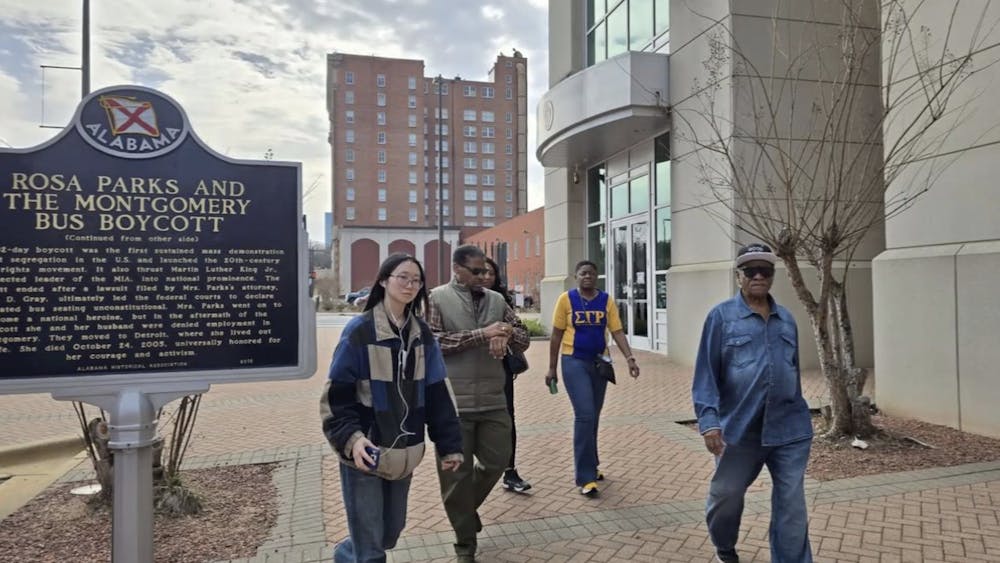Imagine a symposium full of dance, comedy, art and poetry. Then, imagine a space where queer and straight people alike can express their ideas about sexual health and pleasure openly. Combine those two, and you get Emory University’s Sexual Health Art Show and Exhibition (SHASE).
The Emory Reproductive Health Association, La Alianza LatinX and the Queer/Trans Collaborative at Rollins hosted SHASE at the Hatchery on Oct. 28 to normalize discussions about sexual health and pleasure through art. SHASE included performances from multiple dancers, comedians and a poet. A visual art gallery featured work from two artists, including artwork created by Tomorrow Bowen (23PH). Bowen’s “Manifest/Outro” is a multimedia piece featuring images and drawings of Black women as well as writing.
The other visual artist, Quasheba Allen (23PH), contributed their pieces “Nipple Through the Eyeglass” and “Blernde.” While the former explores pleasure and erogenous regions, the latter has more to do with queer identity. “Blernde” was inspired by time when Quasheba helped a friend with their hair, but the meaning of the piece goes much deeper.
“Barbershops are usually sites [of] homophobia, can be transphobi[c], [with] like a lot of cultural shame and stigma and, as queer people, it can be hard to find places that are queer affirming,” Quasheba said. “ Hair care is community care, so we’re kind of taking care of each other.”

While the visual art was highlighted, the show heavily featured queer comedians including Cory Isla, Mira Mason, Vandy Beth Glenn, Minori Hinds, Peyton of Troy, Arden Campbell and Gabriela Ramos Tavarez. Each comedian touched on different subjects, all relevant to the themes of SHASE.
While describing a few ridiculous ex-boyfriends and her foolish endeavors as a younger woman, Mason addressed grooming in relationships. Mason was also very interactive with the audience; at one point, a woman in the front row got on one knee and proposed to the comedian as part of a bit.
Peyton delighted the audience with jokes about attractive women on TikTok. Peyton also addressed how virginity is often negatively viewed, and how her misconceptions about it were changed.
Campbell, a transgender comedian, joked about how their gender identity could cause confusion in hookups. Campbell had plenty of fun with wordplay, at one point changing the word filibuster to “fili-bust-in-her,” much to the delight of the young audience. Campbell wasn’t the only comedian who talked about trans identity. Glenn, whose delivery was marked by a hilarious monotone, also touched on her identity as a trans woman.
After the show, Glenn emphasized the importance of art as a medium of communication.
“Art is about everything and everything is about art,” Glenn said. “So, there’s not an issue of humanity that art can’t have something to say about.”
Between the standup routines, two dancers and a poet performed. The latter, Nea Symone, gave a stirring performance of her poem “Possession Charge,” a piece about women wanting control of their own bodies. Her passionate reading of the words was as gripping as the words themselves. This fearless feminist writing complimented the other performances perfectly.
The performances, while different, both centered around the theme of confidence. Kayla Anderson (23PH) gave a performance that started slow and involved many resting positions on the floor, but finished with suggestive and expressive dance moves in front of a mirror. Because of this prop and her casual outfit, Anderson’s performance exuded the confidence of dancing alone in your bedroom.
Jenna Paritee (24PH) danced to “I put a spell on you” by Nina Simone. Her choreography involved much more movement and traditional dance cues, such as the pirouette. If Anderson’s dance was about gaining confidence, Paritee’s was about trying to keep that confidence through hard times and heartbreak.
Paritee and Anderson were great, but Trené Monrōw, a drag performer, stole the show in the dance department. After a spoken message about resilience through an HIV diagnosis, Monrōw defiantly emerged in a magnificent and elaborate red outfit. While dancing and lip syncing to FLOWERS by Kelly Rowland, Monrōw had several wardrobe changes throughout her performance. As if Monrōw’s sexual and defiant dance moves weren’t already enough to get the crowd going, the drag queen moving into the crowd to flirt with a few lucky attendees got the audience even more engaged. Monrōw’s performance perfectly encapsulated the sexy, confident and unabashed energy of the event.
SHASE was a defiant expression of modern sexuality and gender expression. Noting the power of art to evoke emotion, Glenn recognized the importance of the showcase.
“Sex and Gender and sexuality are so basic and core to who we are,” Glenn said. “It’s tremendously important to have something like this to help people get a better understanding of themselves.”








